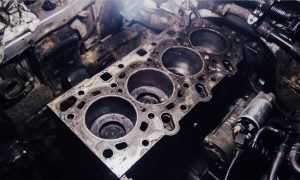Experiencing hard shifting in your vehicle can be concerning. A smooth, seamless transition between gears is crucial for the longevity and performance of your transmission. When you notice that your vehicle shifts roughly or hesitates when changing gears, it’s uncomfortable and could signal potential issues that need to be addressed promptly. This article will help you understand the various factors behind hard shifting and what steps you can take to ensure your vehicle runs smoothly.
What are the Common Symptoms of Hard Shifting
1. Unusual Grinding or Thumping Noises
These transmissions could have grinding, thumping, or clunking noises, especially when your car shifts gears, and such may indicate some mechanical or hydraulic problems, such as low fluid levels or problems with the internal components.
2. Delayed or Rough Shifting
When shifting from one gear to another, you might experience a delay or rough engagement, which could cause the vehicle to lurch forward or jerk abruptly.
3. Unstable Engine RPM

A fluctuating engine RPM while shifting can indicate issues with engine torque, hydraulic pressure, or problems with the transmission solenoid, all of which can affect the shift quality.
4. Check Engine Light
Once this check engine light turns on, it may signal that the vehicle’s computer identified something wrong, ranging from low quantity to faulty sensors or more complex mechanical failure in the car’s transmission system.
5. Inability to Change Gears
If your vehicle struggles to engage or change gears, or if you experience difficulty shifting into 1st, 2nd, or other gears, it can point to mechanical problems such as worn components or fluid contamination.
What are the Basic Mechanics of Transmission Shifting
Transmission shifting involves a multifaceted process guided by hydraulic pressure, electronic solenoids, and mechanical parts. In an automatic transmission, the computer-driven system regulates the timing of a shift, taking into consideration variables like engine load, speed, and throttle position. These systems work together to ensure smooth and timely shifts across different gears (1st gear, 2nd gear, 3rd gear, and beyond).
How Automatic Transmissions Work
Automatic gearboxes depend upon the fluid pressure and computer for when and in which manner this change of gear occurs. The transmission pump generates hydraulic pressure that will circulate through the transmission fluid inside the system. This will create fluid pressure to engage with the right clutch and gearset, thus performing seamless transitions: most automatics contain a type of control center called a valve body that serves to direct the fluid to the appropriate place.
Role of the Transmission Fluid
Transmission fluid plays a very crucial role in maintaining the health of your transmission: it lubricates to reduce friction between internal parts, cleans the debris off the moving parts, and helps modulate hydraulic pressure. Shifting may become jerky or delayed if the fluid is low, dirty, or contaminated.
What are the Key Causes of Hard Shifting
Worn or Contaminated Clutch Components
In automatic transmissions, the clutch components are responsible for smoothly engaging and disengaging gears. Over time, these components can wear down due to constant friction or become contaminated by dirt and debris, leading to rough shifts.
Worn clutch components can cause a noticeable hard shift when engaging higher gears (such as 3rd gear, 5th gear, or 7th gear). Additionally, contamination from old transmission fluid or external factors can damage these components, causing erratic behavior when shifting.
Low Transmission Fluid Levels
Low transmission fluid is one of the most common reasons for rough shifting. It is very critical in providing hydraulic pressure for easy gear shifts. In its shortage, the transmission cannot operate as it should; it causes delayed or harsh shifts mainly from 1st to 2nd gear..
Fluid Leaks
Transmission fluid leaks are a frequent cause of low fluid levels. Over time, seals and gaskets can degrade, allowing fluid to escape. If the fluid level drops too low, the transmission can operate under insufficient pressure, resulting in hard shifting and poor performance.
Fluid Condition
Old, contaminated, or discolored transmission fluid can also lead to rough shifts. Contaminants such as metal shavings, dirt, or carbon buildup can cause the fluid to lose effectiveness. It’s essential to check the fluid condition and color regularly. Clean, high-quality synthetic transmission fluid should appear bright red, while discolored fluid indicates contamination or overheating.
Improperly Adjusted Bands
In older automatic transmissions, bands lock the planetary gears during shifts. If these bands are not adjusted correctly, it can result in delayed or harsh shifts, particularly when changing between gears such as 2nd and 3rd gear.
Issues with Transmission Mounts
Transmission mounts secure the transmission to the vehicle’s frame and engine. If these mounts are worn or damaged, the transmission can shift erratically or make clunking sounds. A broken or loose transmission mount can also cause the engine and transmission to move out of alignment, leading to rough shifting.
What is the Role of the Transmission Fluid

Importance of Fluid Condition
Transmission fluid plays a vital role in the smooth operation of your vehicle’s transmission. It serves as both a lubricant and a coolant, reducing friction and helping to dissipate heat generated by the shifting process. If the fluid is contaminated or at a low level, it may fail to provide adequate lubrication and pressure, leading to issues like rough shifting, slipping, or delayed gear engagement.
Low vs. Contaminated Fluid
Low and contaminated fluid levels are two primary factors leading to transmission problems. Low fluid levels can be rectified by topping up with the appropriate fluid. However, contaminated fluid may require a transmission flush to remove debris and replace the old fluid with fresh, clean fluid.
The Computer’s Relearning Process
Modern vehicles with automatic transmissions are often equipped with adaptive transmissions that “learn” how the driver operates the car. This system adjusts shift points based on driving patterns and engine load. If the vehicle has undergone maintenance or the battery has been disconnected, the system may need to relearn the proper shift timing.
Software Update
Sometimes these problems are due to software in control of transmission behavior. A manufacturer’s upgrade may fix key issues like rough shifting or delayed and inappropriate shift patterns. These need to be kept up to date for ideal transmission performance. It’s essential to stay up-to-date with these updates to ensure optimal transmission performance.
DIY Solutions for Smoother Shifting
While some transmission issues require professional help, there are a few things you can check and adjust yourself before heading to a transmission shop.
1. Check Fluid Levels
Check the transmission fluid level regularly to ensure it’s within the recommended range. If it is low, topping it up with the appropriate transmission fluid may resolve the issue.
2. Transmission Flush
If the fluid appears contaminated, a transmission flush can help remove dirt and debris, restore fluid efficiency, and potentially resolve shifting issues.
3. Inspect Transmission Mounts
Inspect the transmission mounts for signs of wear or damage. If the mounts are broken or loose, they may need to be replaced to ensure smooth shifting.
4. Check for Leaks
Look for any signs of fluid leaks around the transmission pan, seals, and hoses. The source should be repaired to prevent further fluid loss if a leak is found.
When to Seek Professional Help

Some issues with transmission shifting may be more complex and require the attention of a professional technician. If the following signs are present, it’s time to visit a transmission shop:
1. Persistent Check Engine Light
If the check engine light remains on, it could indicate a serious issue with the transmission or related components, such as the shift solenoid or transmission filter.
2. Delayed Shifting
A significant shift delay, particularly in multiple gears, could point to a hydraulic issue or problem with the transmission control module.
3. Rough Shifting That Doesn’t Improve
If the rough shifting persists despite checking fluid levels and other simple fixes, it’s time to seek professional assistance to diagnose internal transmission issues.
Conclusion
Hard shifting can stem from a variety of causes, ranging from simple fluid issues to more complex mechanical problems. Understanding the basics of transmission mechanics and identifying the signs of hard shifting will help you address the problem early. Regular fluid maintenance, checking for leaks, and keeping an eye on the condition of components like the transmission filter and mounts can prevent many issues. If you’re unsure what’s causing the problem, don’t hesitate to consult a professional transmission shop for a thorough inspection and diagnosis.
ALSO READ: What Causes a Car to Jerk When Driving
FAQs
You should check your transmission fluid level at least once every 30,000 miles or as your vehicle’s owner’s manual recommends. However, if you’re experiencing rough shifting, checking more frequently is a good idea.
Yes, a faulty shift solenoid can cause rough shifting, as it controls the flow of transmission fluid to the appropriate gears. If it malfunctions, it can lead to erratic shifting behavior.
Low transmission fluid is one of the most common reasons for hard shifting. Fluid is essential for proper hydraulic pressure; without enough fluid, the transmission cannot shift smoothly.
Brown or black fluid indicates that it’s old and contaminated. If the fluid is discolored, it may not provide adequate lubrication and could cause transmission issues. A fluid change or transmission flush may be necessary.




